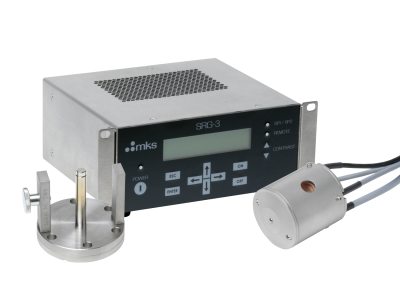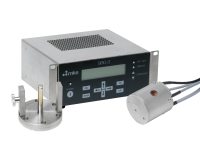Spinning Rotor Vacuum Gauge Transfer Standard
Overview
The Spinning Rotor Gauge is a high-vacuum gauge that operates by measuring the amount of viscous drag on a magnetically-levitated spinning ball, which is directly related to the number of molecules in the chamber. It is commonly used for calibration and metrology of other high-vacuum gauge sensors such as cold cathode and hot-filament ionization tubes. Its accuracy specification of 1% of reading is guaranteed over the range of 1 x 10-2 Torr (mbar) to 5 x 10-7 Torr (mbar).
- Transfer standard for calibration in 10-2 to 10-7 Torr vacuum range, DKD traceable
- Overall measurement range up to 1 Torr/mbar (with reduced accuracy)
- Insensitive to ionization effects from other vacuum gauges
- Stainless steel wetted surfaces
- Multiple outputs such as RS232, USB, high-resolution analog, and discrete trip relays
- CE and RoHS compliant
Products
| Compare | Description | Drawings, CAD & Specs | Availability | Price | |||
|---|---|---|---|---|---|---|---|

|
SRG3-EL Electronics Module, Spinning Rotor Gauge |
8 Weeks
|
$18,840 |
|
|||

|
SRG-SH700-V3 Measurement Head, Spinning Rotor Vacuum Gauge System, Includes Cable |
8 Weeks
|
$4,170 |
|
|||

|
SRG-BF-CAL Ball and Flange Assembly, Spinning Rotor Vacuum Gauge System, Calibrated |
8 Weeks
|
$1,995 |
|
|||

|
SRG-BF Ball and Flange Assembly, Spinning Rotor Vacuum Gauge System, Not Calibrated |
8 Weeks
|
$1,240 |
|
Specifications
-
Measurement Range5 x 10-5 to 100 Pa
-
Accuracyup to 1 Pa: 1% of measuring value + U
1 to 100 Pa: increasing up to 10% of measured value (typical) -
StabilityBetter than 1% per year
-
Display4½ digit LCD display
-
Display UnitsPa, mbar, or Torr
-
Analog Output0-10 VDC, into 2kΩ min. load, linear or logarithmic
-
Relays2 SPDT relays, adjustable, nominal switching capacity (resitive load): 1A 30VDC, 0.5A 25VAC
-
Digital CommunicationRS-232, USB (USB 2.0 compatible)
-
Flange Type2¾ CF, made of stainless steel, bakeable up to 450°C (without measuring head)
-
Operating TemperatureElectronics: 10-40°C
Measuring head: 10-50°C ball/flange assembly bakeable to 450°C -
EnclosureHalf 19-inch rack mount or table top, 241 x 185 x 88 mm
-
WeightElectronics: 2.5 kg
Measuring head: 0.6 kg
Measuring flange: 0.5 kg -
Power Requirements85 to 256 VAC, 47-63 Hz
-
Wetted MaterialsBall and Flange
-
ComplianceCE
Features
Principle of a Spinning Rotor Gauge
The sensing element of the SRG is a magnetically levitated stainless steel ball that resides in a tube connected to the vacuum system. The ball is suspended and rotated by the separable drive assembly. Once the ball reaches a certain rotational speed, the ball is allowed to free spin. Collisions of the gas molecules with the surface of the ball impart a drag which decelerates the ball. Pickup coils measure the deceleration. The electronics unit then uses an algorithm based on the sampling time, physical parameters and gas characteristics to accurately determine the pressure.
Since the measurement principle is mechanical, there are no thermal or ionization effects (as is the case with ionization gauges) that will influence the accuracy of the measurements. Also, the calibration constant is only weakly influenced by the ball’s surface roughness, making the SRG a very stable reference standard.
Applications
The SRG-3 will find applications in metrology and in experiments where high accuracy and repeatability are essential. Away from the test bench, the MKS Spinning Rotor Gauge may also be used in situ on a process chamber to assure high vacuum gauge reading accuracy and tool-to-tool consistency.This provides repeatable process results, high uptime and optimum cycle times.
Calibration
MKS Instruments, Inc. delivers the SRG-3 with a calibrated measuring head and ball/flange assembly along with a calibration certificate. Calibration is made against the reference standards of our DKD1 calibration laboratory. As a result, the Spinning Rotor Gauge SRG-3 system offers the user consistent traceability as required for ISO9000. Should measuring flanges with non-calibrated balls be ordered, they will be checked for usability by the factory.
Resources
Drawings & CADs
- SRG-3 Spinning Rotor Gauge System Dimensional Drawing (130.2 kB, PDF)
Manuals
- SRG-3 Spinning Rotor Gauge Manual (1.1 MB, PDF)
- SRG-3 Spinning Rotor Gauge RS232 Interface Manual (179.9 kB, PDF)



 Ultra-High Velocity
Ultra-High Velocity